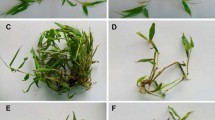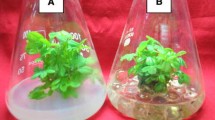Abstract
In vitro shoot regeneration of gladiolus in three different culture systems, viz., semi-solid agar (AS), membrane raft (MR), and duroplast foam liquid (DF) cultures was evaluated following the kinetics of shoot multiplication and hyperhydricity at optimized growth regulator combinations. Compared to the AS system, matrix-supported liquid cultures enhanced shoot multiplication. The peak of shoot multiplication rate was attained at 18 days of incubation in the MR and DF systems, whereas the maximum rate in the AS system was attained at 21 days. An early decline in acceleration trend was observed in liquid cultures than the AS culture. The hyperhydric status of the regenerated shoots in the different culture systems was assessed in terms of stomatal attributes and antioxidative status. Stomatal behavior appeared to be normal in the AS and MR systems. However, structural anomaly of stomata such as large, round shaped guard cells with damage in bordering regions of stomatal pores was pronounced in the DF system along with a relatively higher K+ ion concentration than in the AS and MR systems. Antioxidative status of regenerated shoots was comparable in the AS and MR systems, while a higher incidence of oxidative damages of lipid membrane as evidenced from malondialdehyde and ascorbate content was observed in the DF system. Higher oxidative stress in the DF system was also apparent by elevated activities of superoxide dismutase, ascorbate peroxidase, and catalase. Among the three culture systems, liquid culture with MR resulted in maximum shoot multiplication with little or no symptoms of hyperhydricity. Shoots in the DF system were more prone to hyperhydricity than those in the AS and MR systems. The use of matrix support such as membrane raft as an interface between liquid medium and propagating tissue could be an effective means for rapid and efficient mass propagation with little or no symptoms of hyperhydricity.





Similar content being viewed by others
References
Adelberg J (2006) Agitated thin-films of liquid media for efficient micropropagation. In: Dutta Gupta S, Ibaraki Y (eds) Plant tissue culture engineering. Springer, The Netherlands, pp 103–117
Arora A, Sairam RK, Srivastava GC (2002) Oxidative stress and antioxidative system in plants. Curr Sci 82:1227–1238
Bailly C, Benamar A, Corbineau F, Dôme D (1996) Changes in malondialdehyde content and in superoxide dismutase, catalase and glutathione reductase activities in sunflower seed as related to deterioration during accelerated aging. Physiol Plant 97:104–110
Beauchamp C, Fridovich I (1971) Superoxide dismutase: improved assays and an assay applicable to polyacrylamide gels. Anal Biochem 44:276–287
Beers RF, Sizer IW (1952) A spectrophotometric method for measuring breakdown of hydrogen peroxide by catalase. J Biol Chem 195:133–140
Benson E (2000) Do free radicals have role in plant tissue culture recalcitrance? Special symposium: in vitro plant recalcitrance. In Vitro Cell Dev Biol-Plant 36:163–170
Chakrabarty D, Park SY, Ali BM, Shin KS, Paek KY (2006) Hyperhydricity in apple: ultrastuctural and physiological aspects. Tree Physiol 26:377–388
Chen SX, Schopfer P (1999) Hydroxyl-radical production in physiological reactions. A novel function of peroxidase. Eur J Biochem 260:726–735
Chen J, Ziv M (2001) The effect of ancymidol on hyperhydricity, regeneration, starch and antioxidant enzymatic activities in liquid-cultured Narcissus. Plant Cell Rep 20:22–27
Chen J, Ziv M (2004) Ancymidol-enhanced hyperhydric malformation in relation to gibberellin and oxidative stress in liquid cultured Narcissus leaves. In Vitro Cell Dev Biol-Plant 40:613–616
Debergh PC, Aitken-Christie J, Cohen D, Grout B, von Arnold S, Zimmerman R, Ziv M (1992) Reconsideration of the term ‘vitrification’ as used in micropropagation. Plant Cell Tissue Organ Cult 30:135–140
Desamero NV, Adelberg JW, Hale SA, Young RE, Rhodes BB (1993) Nutrient utilization in liquid/membrane system for watermelon micropropagation. Plant Cell Tissue Organ Cult 33:265–271
Dewir YH, Chakrabarty D, Ali MB, Hahna EJ, Paek KY (2006) Lipid peroxidation and antioxidant enzyme activities of Euphorbia millii hyperhydric shoots. Environ Exp Bot 58:93–99
Dutta Gupta S, Datta S (2004) Antioxidant enzyme activities during in vitro morphogenesis of gladiolus and the effect of application of antioxidants on plant regeneration. Biol Plant 47:179–183
Fontes MA, Otoni WC, Carolino SMB, Brommonschenkel SH, Fontes EPB, Fa′ri M, Louro RP (1999) Hyperhydricity in pepper plants regenerated in vitro: involvement of BiP (Binding Protein) and ultrastructural aspects. Plant Cell Rep 19:81–87
Franck T, Kevers C, Penel C, Greppin H, Hausman JF, Gaspar T (1998) Reducing properties and markers of lipid peroxidation in normal and hyperhydrating shoots of Prunus avium L. J Plant Physiol 153:339–346
Franck T, Kevers C, Gaspar T, Dommes J, Deby C, Greimers R, Serteyn D, Deby-Dupont G (2004) Hyperhydricity of Prunus avium shoots cultured on gelrite: a controlled stress response. Plant Physiol Biochem 42(6):519–527
Gasper T, Penel C, Greppin H (1975) Peroxidase and isoperoxidases in relation to root and flower formation. Plant Biochem J 2:33–47
Gressel J, Galun E (1994) Causes of photooxidative stress and amelioration of defence systems in plants. In: Foyer CH, Mullineaux PM (eds) CRC Press, Boca Raton, FL, pp 237–274
Han BH, Paek KY, Choi JK (1992) Structural characteristics of vitrified and glaucous plantlets in Gypsophila paniculata L. in vitro. J Kor Soc Hortic Sci 33:177–189
Hazarika BN (2006) Morpho-physiological disorders in in vitro culture of plants. Sci Hort 108:105–120
Heath RL, Packer L (1968) Photoperoxidation in isolated chloroplasts. I: Kinetics and stoichiometry of fatty acid peroxidation. Arch Biochem Biophys 125:189–198
Hodges DM, DeLong JM, Forney CF, Prange RK (1999) Improving the thiobarbituric acid-reactive-substances assay for estimating lipid peroxidation in plant tissues containing anthocyanin and other interfering compounds. Planta 207:604–611
Kevers C, Franck T, Strasser RJ, Dimmes J, Gaspar T (2004) Hyperhydricity of micropropagated shoots: a typical stress induced state of physiological state. Plant Cell Tissue Organ Cult 77:181–191
Laemmli UK (1970) Cleavage of structural proteins during the assembly of the head of bacteriophage T4. Nature 227:680–685
Law MY, Charles SA, Halliwell B (1983) Glutathione and ascorbic acid in spinach (Spinacia oleracea) chloroplasts. The effect of hydrogen peroxide and of paraquat. Biochem J 210:899–903
Lin S, Zhang Z, Lin Y, Liu W, Guo H, Zhang W, Zhang C (2004) Comparative study on antioxidative system in normal and vitrified shoots of Populus suaveolens in tissue culture. For Stud China 6(3):1–8
Lowry DH, Rosebrough NJ, Farr AL, Randall RJ (1951) Protein measurement with the Folin-phenol reagent. J Biol Chem 193:265–295
Mendes BMJ, Filippi SB, Demétrio CGB, Rodriguez APM (1999) A statistical approach to study the dynamics of micropropagation rates, using banana (Musa spp.) as an example. Plant Cell Rep 18:967–971
Murashige T, Skoog F (1962) A revised medium for rapid growth and bioassays with tobacco tissue culture. Physiol Plant 15:473–497
Nhut DT, Teixeira da Silva JA, Huyen PX, Paek KY (2004) The importance of explant source on regeneration and micropropagation of gladiolus by liquid shake culture. Sci Hort 102:407–414
Olmos E, Hellin E (1998) Ultrastructural differences in hyperhydric and normal leaves from regenerated carnation plants. Sci Hort 75:91–101
Pandey S, Zhang W, Assmann SM (2007) Roles of ion channels and transporters in guard cell signal transduction. FEBS Lett 581:2325–2336
Papadakis AK, Roubelakis-Angelakis KA (2002) Oxidative stress could be responsible for the recalcitrance of plant protoplasts. Plant Physiol Biochem 40:549–559
Picoli EAT, Otoni WC, Figueira ML, Carolino SMB, Almeida RS, Silva EAM, Carvalho CR, Fontes EPB (2001) Hyperhydricity in in vitro eggplant regenerated shoots: structural characteristics and involvement of BiP (Binding Protein). Plant Sci 160:857–868
Piqueras A, Han BH, Van Huylenbroeck JM, Debergh PC (1998) Effect of different environmental conditions in vitro on sucrose metabolism and antioxidant enzymatic activities in cultured shoots of Nicotiana tabacum L. Plant Growth Reg 25:5–10
Piqueras A, Cortina M, Serna MD, Casas JL (2002) Polyamines and hyperhydricity in micropropagated carnation shoots. Plant Sci 162:671–678
Prasad VSS, Dutta Gupta S (2006) In vitro shoot regeneration of gladiolus in semi-solid agar versus liquid cultures with support systems. Plant Cell Tissue Organ Cult 87:263–271
Saher S, Piqueras A, Hellin E, Olmos E (2004) Hyperhydricity in micropropagated carnation shoots: the role of oxidative stress. Physiol Plant 120(1):152–161
Saher S, Fernández-García N, Piqueras A, Hellín E, Olmos E (2005) Reducing properties, energy efficiency and carbohydrate metabolism in hyperhydric and normal carnation shoots cultured in vitro: a hypoxia stress? Plant Physiol Biochem 43(6):573–582
Salisbury EJ (1927) On the causes and the ecological significance of stomatal frequency with special reference to teh woodland flora. Philos Trans R Soc Lond B 216:1–65
Sampson J (1961) A method of replacing dry or moist surfaces for examination by light microscopes. Nature 191:932
Schroeder JI (2003) Knockout of the guard cell K+ out channel and stomatal movements. Proc Natl Acad Sci USA 100:4976–4977
Steinitz BA, Cohen Z, Kochba GM (1991) Precocious gladiolus corm formation in liquid shake cultures. Plant Cell Tissue Organ Cult 26:63–70
Ticha I, Radochova B, Kadlecck P (1999) Stomatal morphology during acclimatization of tobacco plantlets to ex vitro conditions. Biol Plant 42:469–474
Werker E, Leshem B (1987) Structural changes during vitrification of carnation plantlets. Ann Bot 59:377–385
Ziv M (1989) Enhanced shoot and cormlet proliferation in liquid cultured Gladiolus buds by growth retardants. Plant Cell Tissue Organ Cult 17:101–110
Ziv M (1991) Vitrification: morphological and physiological disorders of in vitro shoots. In: Debergh PC, Zimmerman RH (eds) Micropropagation. Kluwer, Dordrecht, pp 45–69
Ziv M (2005) Simple bioreactors for mass propagation of plants. Plant Cell Tissue Organ Cult 8:277–285
Ziv M, Ariel T (1994) Vitrification in relation to stomatal deformation and malfunction in carnation leaves in vitro. In: Lumsden PJ, Nicholas J, Davies WJ (eds) Physiology, growth and development of micropropagated plants. Kluwer, Dordrecht, pp 143–154
Ziv M, Schwartz A, Fleminger D (1987) Malfunctioning stomata in vitreous leaves of carnation plants propagated in vitro: implication for hardening. Plant Sci 52:127–134
Acknowledgment
V.S.S. Prasad was supported by a Senior Research Fellowship from the CSIR, New Delhi.
Author information
Authors and Affiliations
Corresponding author
Rights and permissions
About this article
Cite this article
Dutta Gupta, S., Prasad, V.S.S. Shoot multiplication kinetics and hyperhydric status of regenerated shoots of gladiolus in agar-solidified and matrix-supported liquid cultures. Plant Biotechnol Rep 4, 85–94 (2010). https://doi.org/10.1007/s11816-009-0124-5
Received:
Accepted:
Published:
Issue Date:
DOI: https://doi.org/10.1007/s11816-009-0124-5




